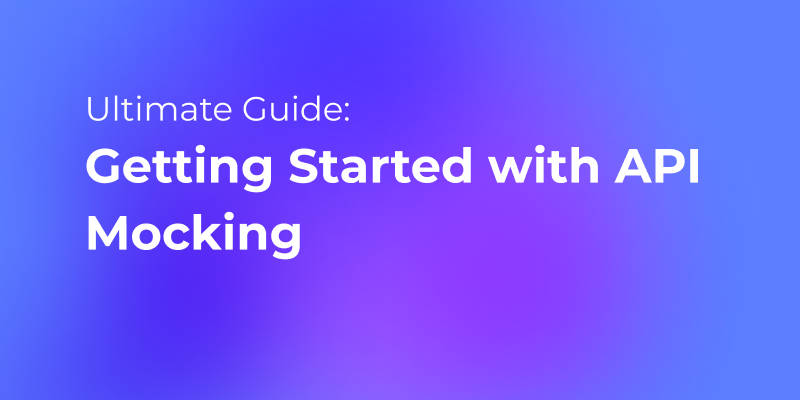Mocking APIs is vital for simulating responses and scenarios during API testing. With API usage growing, mocking tools have become essential for developers. This review covers the top 10 API mocking tools to consider in 2025 based on features, ease of use, and platform.
What are API Mocking Tools?
API mocking tools typically provide a way to create a mock version of an API, configure it to return specific responses to incoming requests and simulate different scenarios and behaviors. It allows developers to test their applications or services without relying on a live API and can be configured to return specific responses to incoming requests.
This can include simulating error responses, latency, and other types of responses that may be difficult or impossible to reproduce with a live API.

When We Need Mocking API?
There are several situations in which mock APIs can be useful:
- Testing: Mocking APIs can be used to test the functionality of an application or service without relying on a live API. This can be useful for testing the robustness and reliability of an application or service and can help developers identify and troubleshoot any issues that may arise.
- Development: Mock APIs can be used to develop and test applications or services without having to wait for a live API to be available. This can be especially useful when the live API is not yet available, or when it is not feasible to use a live API for development or testing purposes.
- Simulation: Mocking APIs can be used to simulate different scenarios and behaviors that may be difficult or impossible to reproduce with a live API. This can include simulating error responses, latency, and other types of responses that may be difficult or impossible to reproduce with a live API.
- Isolation: Mocking APIs can be used to isolate an application or service under development from other systems, allowing developers to focus on the functionality of the application or service without being affected by external factors.
Overall, mocking APIs can be useful in a variety of situations where it is necessary or desirable to test or develop an application or service without relying on a live API.
Top 10 API Mocking Tools in 2025
There are many different API mocking tools on the market, each with its own set of features and capabilities. In this review, we will take a look at some of the top API mocking tools, including their features, capabilities, and any relevant details such as supported platforms, pricing, and documentation.
API Mocking Tool Top 1: Apidog
Apidog is a free platform or tool that allows you to import an API definition and generate mock data for testing and development purposes. Its smart mock feature can generate mock data automatically based on the names of fields, allowing you to create realistic mock data without having to manually specify the values for each field.

One of the benefits of using Apidog is that the mock data is generated automatically, and it changes each time the URL is requested. This can be useful for testing applications or services that rely on dynamic data, as it allows you to test how the application or service handles different sets of data.
Apidog is free to mock API, making it a good choice for developers who need a simple tool for testing and development purposes.


API Mocking Tool Top 2: Postman
Postman is a popular tool for testing and interacting with APIs. Its "Mock Servers" feature allows you to set up a mock version of your API and configure it to return specific responses to incoming requests.
This can be useful for testing the functionality of your application or service without having to rely on an API and can help you identify and troubleshoot any issues that may arise.
However, Postman may not provide as many tools for API design and mock server management as some other platforms, and may not be suitable for developers who need more advanced or customized mock server functionality.

API Mocking Tool Top 3: Mocki
Mocki is an online tool for creating and hosting mock APIs. It allows you to set up a mock version of your API and configure it to return specific responses to incoming requests. mocki.io is relatively easy to use and has a wide range of features for mocking and simulating APIs, including support for importing and exporting mock configurations, generating random data for responses, and setting up conditional responses based on the contents of incoming requests.

One of the benefits of using Mocki is that it is a cloud-based tool, meaning that you can access and manage your mock APIs from anywhere with an internet connection. This can be especially useful for developers who need to collaborate with team members or clients remotely, as it allows everyone to access the mock APIs from their own devices.
Overall, Mocki can be a useful tool for testing and development purposes, particularly for developers who need a cloud-based solution for creating and managing mock APIs.
API Mocking Tool Top 4: Mockoon
Mockoon is an open-source tool for creating and managing mock servers. It allows you to set up a mock version of your API and configure it to return specific responses to incoming requests.
Mockoon is relatively easy to use and has a wide range of features for mocking and simulating APIs, including support for importing and exporting mock configurations, generating random data for responses, and setting up conditional responses based on the contents of incoming requests.

API Mocking Tool Top 5: Stoplight
Stoplight is a platform for designing, documenting, and testing APIs. Its "Mocks" feature allows you to create mock versions of your API for testing and development purposes. In addition to the mock feature, Stoplight also includes tools for API design, documentation, and testing, making it a comprehensive platform for API development.

However, Stoplight may be more complex to use and may require a subscription to access all of its features, making it less suitable for developers who are looking for a simple or free tool for testing and development purposes.
API Mocking Tool Top 6: MockAPI
MockAPI is a tool for creating and hosting mock APIs. It allows you to set up a mock version of your API and configure it to return specific responses to incoming requests. mockAPI is relatively easy to use and has a wide range of features for mocking and simulating APIs, including support for importing and exporting mock configurations, generating random data for responses, and setting up conditional responses based on the contents of incoming requests.
One of the benefits of using MockAPI is that it is a cloud-based tool, meaning that you can access and manage your mock APIs from anywhere with an internet connection. This can be especially useful for developers who need to collaborate with team members or clients remotely, as it allows everyone to access the mock APIs from their own devices.
Overall, MockAPI can be a useful tool for testing and development purposes, particularly for developers who need a cloud-based solution for creating and managing mock APIs.

API Mocking Tool Top 7: WireMock
WireMock is a Java-based library for stubbing and mocking web services. It is relatively simple to use and has a wide range of features for stubbing and mocking web services, including the ability to set up conditional responses based on incoming requests, simulate latency, and record and replay HTTP traffic.
This can be useful for testing the functionality of your application or service in different scenarios and can help you identify and troubleshoot any issues that may arise. WireMock is open-source and available for free, making it a good choice for developers who need a simple tool for testing and development purposes. However, it may not be as easy to use for developers who are not familiar with Java and may not provide as many features or customization options as some other tools.
API Mocking Tool Top 8: Mountebank
Mountebank is a cross-platform tool for creating mock servers and stubbing HTTP APIs. It allows you to specify the behavior of your mock server using a simple configuration file, and can be used to simulate a variety of different scenarios, such as error responses and latency.
This can be useful for testing the robustness and reliability of your application or service and can help you identify and troubleshoot any issues that may arise. Mountebank is open-source and available for free, making it a good choice for developers who need a flexible tool for simulating different scenarios and behaviors. However, it may not be as easy to use for developers who are not familiar with its configuration file format, and may not provide as many features or customization options as some other tools.
API Mocking Tool Top 9: Apigee
Apigee is a comprehensive platform for designing, building, and testing APIs. It includes a feature called "API mocking," which allows you to create a mock version of your API for testing and development purposes. In addition to the mock feature, Apigee also includes a wide range of tools for API development, including support for API design, documentation, testing, and deployment.
However, Apigee may be more complex to use and requires a subscription to access all of its features, making it less suitable for developers who are looking for a simple or free tool for testing and development purposes.
API Mocking Tool Top 10: Hoverfly
Hoverfly is an open-source tool for mocking and simulating APIs. It is relatively easy to use and has a wide range of features for mocking and simulating APIs, including support for importing and exporting mock configurations, generating random data for responses, and setting up conditional responses based on the contents of incoming requests.
This can be useful for testing the functionality of your application or service in different scenarios and can help you identify and troubleshoot any issues that may arise.
Comparison Of the Best 10 API Mocking Tools
| Tool | Features | Pricing | Ease of use | Platform |
|---|---|---|---|---|
| Apidog | Smart Mock feature for generating mock data automatically based on field names; free to use | Free | Easy | Web-based |
| Postman | Mock Servers feature for setting up a mock version of an API and configuring it to return specific responses to incoming requests; support for API design, documentation, and testing | Free | Easy | Windows, Mac, Linux |
| WireMock | Support for setting up conditional responses based on incoming requests, simulating latency, and recording and replaying HTTP traffic; open-source and free to use | Free | Moderate | Java |
| Mountebank | Support for specifying the behavior of a mock server using a configuration file; open-source and free to use | Free | Moderate | Windows, Mac, Linux |
| Apigee | API mocking feature for creating a mock version of an API; support for API design, documentation, testing, and deployment; subscription required for access to all features | Subscription | Moderate | Web-based |
| Hoverfly | Support for importing and exporting mock configurations, generating random data for responses, and setting up conditional responses based on incoming requests; open-source and free to use | Free | Moderate | Windows, Mac, Linux |
| Stoplight | Mocks feature for creating mock versions of an API; support for API design, documentation, and testing; subscription required for access to all features | Subscription | Moderate | Web-based |
| Mockoon | Support for importing and exporting mock configurations, generating random data for responses, and setting up conditional responses based on incoming requests; open-source and free to use | Free | Easy | Windows, Mac, Linux |
| Mocki | Support for importing and exporting mock configurations, generating random data for responses, and setting up conditional responses based on incoming requests; cloud-based | Free | Easy | Web-based |
| mockAPI | Support for importing and exporting mock configurations, generating random data for responses, and setting up conditional responses based on incoming requests; cloud-based | Free | Easy | Web-based |
From this article, you may already have a clear understanding of the API mocking tools, hope to help you make a choice. If you want to further know how to mock an API request, check the post below:





